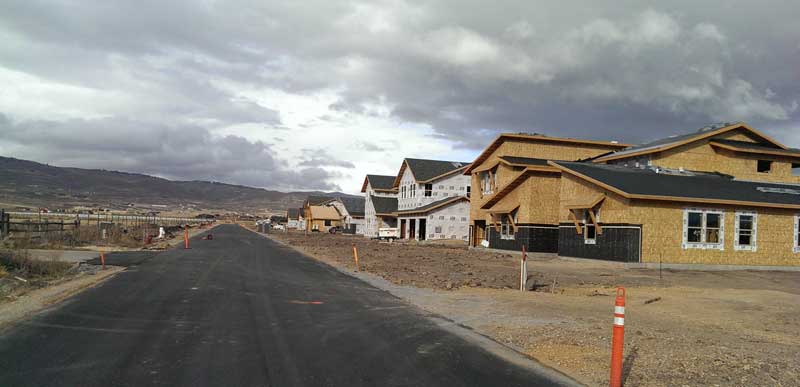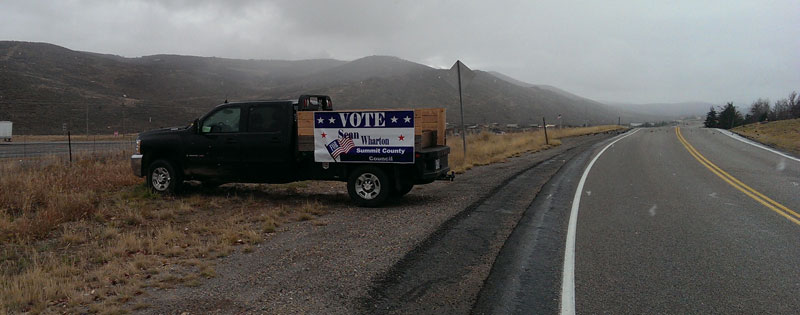Loco Lizard Restaurant Inspection
Summit County Health Department inspected Loco Lizard on 10/14/2014. We have created a page on how to read the Inspection Report. We’ll highlight the things that may be of interest. Please read the full report below for a complete and accurate report.
Good Practices:
- In use utensils properly stored
- Physical facilities installed, maintained and cleaned
Temperatures:
- Steak / Walk-in 43º
- Shrimp / Reach-in 27º
- Seafood Mix / Cold-hold 45º
- Pork / Hot-hold 162º
- Chicken / Hot-hold 150º
Observations and Corrective Actions:
- Don’t store dirty utensils on wall
- Clean ice machines, floor drain, cover for light dry storage
- Sanitizer isn’t entering dishwasher
- Clan microwave every 24 hours
- Use gloves with ready-to-eat foods
- Front Reach-in above 41º
Jordanelle Special Services District Sued for Defaulting on Bonds
We received an email over the weekend tipping us off to the fact that Jordanelle Special Services District (JSSD) was being sued by Wells Fargo and USSA for defaulting on its bond obligations. According to the complaint provided, “Plaintiffs [Wells Fargo and USSA] purchased revenue bonds from the Defendants [JSSD], thereby investing nearly $30 million in Defendants’ projects in Wasatch County. Defendants rewarded the Plaintiffs’ investment by defaulting on the bonds, acting in bad faith and against the rights of the Bondholders, mismanaging the properties underlying the bonds, violating the Utah Assessment Act, and improperly using the bond proceeds in an attempt to gain a windfall at the expense of the Bondholders.”
JSSD is a special service district that serves the citizens of the Jordanelle Basin in Wasatch County for both water delivery and waste water systems. According to the complaint filed in district court, properties within the district were foreclosed upon by Wastach County (which eventually became the property owner). The complaint then states that Wasatch County did not continue to pay bond payments to Wells Fargo and USSA (the buyers of the bonds, along with Koch financial who is not part of this suit) but instead tried to force the foreclosed properties back on Wells Fargo and USSA (the plaintiffs). The plaintiffs argue that this is not legal and that Wasatch County should be held liable for paying for bond payments that it has foreclosed upon and currently holds.
The plaintiffs are asking for compensatory damages, putting certain funds collected by JSSD into a trust, a court appointed receiver to manage the JSSD water reclamation facility, an order from the court assuring that Wasatch County is the responsible party, and costs associated with this legal action.
So, why should you care about this? Well, if you are in Wasatch County, there is a chance that you are going to not only going to pay for this legal action but also for the amount owed on the $30 million worth of bonds sold (even if you don’t live in this special service area). If Wasatch County ends up having to pay bond holders (either all at once or on the bond schedule) you know who Wasatch County really is? You and your property taxes… or should we say you and more of your property taxes.
If you are in Summit County, this is a cautionary tale for now. However, whenever a bond is issued by a Special Services District, the governing board is on the hook for it. For instance, say a bond was issued by a new “Silver Creek Sewer District” for $25 million to put in a sewer in Silver Creek. Then a bunch of homes were foreclosed on and ended up being owned by Summit County. The bond still has to be paid. Who pays it? All Summit County residents. Likewise, say the Basin Rec bond passes this year. If something happens, all of Summit County is ultimately liable for the bond and any legal fees. It’s just something to think about.
There is much more to this story, including some interesting audio of testimony under oath by a JSSD board member in front of a Utah Legislative committee that may or may not exactly jibe with the legal complaint filed. We have to do more research on that. So, expect more over the coming few days.
Update: We never followed up on the audio recording and the recommendation from our source to listen to it. It allegedly contained some interesting information per our source; however, about that time the Salt Lake media had picked up on the story and we decided they likely had more time to investigate.
h/t to the citizen who provided this information. This is exactly the type of information that we as citizens deserve unfettered access to. We really appreciate your efforts.
Summit County Health Department Prepares for Ebola
On Wednesday, the Summit County Health Department will make a presentation on steps taken to prepare for an Ebola outbreak in Utah. While some may say that’s a bit overboard, we believe it’s appropriate. The CDC says there will be between 550,000 and 1.4 million cases in West Africa by the end of 2015. RMS, a risk management firm estimates there will be between 15 and 130 cases of Ebola in the U.S. by the end of this year (mostly medical personnel returning from Africa). So, now is the time to prepare for the eventuality of someone in Utah having the disease.
Please don’t get us wrong, we don’t expect some MorganFreeman-DustinHoffman event but we think preparedness is important. We all know how Park City parents act when a stray peanut is found at school. How is the Park City public going to behave when an Ebola case pops up in SLC?
So, we think having a policy and process in place not only shows forethought but could help in the case of another, more transmittable disease, like Avian flu, that could become a problem in the future. While it’s likely that these plans won’t be needed for Ebola, it shows that our Health Department has contingencies in place, should the unexpected happen.
We encourage you to take a look at the plan. It’s pretty well thought out.
Update: We just read in Forbes why we aren’t hearing much anymore about Ebola. The Reason? The Associated Press and other news outlets have agreed not to report on suspected cases of Ebola until a positive viral RNA test is completed.
Thoughts on East Creek Ranch
East Creek Ranch is the new home development on the north side of I-80 near the Highway 40 exit. You could think of it as “Silver Creek Valley.” We spent some time researching it and walking around the area this weekend. Here are some random thoughts:
- Homes range in size from 2600 sq ft to 5000 sq ft.
- Prices range from $660K to $890K
- Many of these homes are going to have a great view of the mountain range (and Canyons). It’s that view of Park City that you get when driving in from Wyoming.
- These houses seem CLOSE TOGETHER. They aren’t as close as Silver Springs houses but they are going to be larger. This is likely going to feel cramped when built out.
- People are used to seeing a wide open field with sheep there. It will look very different with 60+ houses down in that valley. This is going to change the feel of the Park City drive-by substantially.
- Will the Walmart Neighborhood Market go here or by Home Depot?
- No basements? Why?
- Woodside Homes, the builder, is offering 30-year FHA loans for these properties with a 5.5% APR. According to bankrate.com FHA loans are often given with less stringent qualifications and requirements. That’s “great” for our community.
- We listened to two of Park City’s top realtors on the radio Friday. They were talking about how people were buying at Jordannelle because homes started at about $500,000 and the homes were new. What will this (and Park City Heights) do to home values in Pinebrook, Jeremy, and Silver Springs? Do you want to live in a 10 year old home in Silver Springs for $600,000 or new home here for $650,000?
- The again, according to those same Realtors, home prices are topping out at $750K in Pinebrook and Jeremy Ranch, due to the maximum loans people can get. Who is going to be able to get a loan for $800K here? These likely are the same buyers who would be buying in Pinebrook or Jeremy.
- People living out on the road behind these houses aren’t going to be happy. There goes the view and the likely reason they were out there in the first place.
You May Want To Attend Tuesday’s Snyderville Basin Planning Commission Meeting
If you are looking for one county meeting that packs in lots of information, Tuesday’s Basin Planning Commission meeting has it. Big topics include:
- Update on the County’s website
- Mountain Accord Presentation
- Status update on revisions to General Plan
- Discussion regarding Long Range Transportation plan
These are THE TOPICS that are hot and heavy at the moment. It’s a great opportunity to learn a lot about what’s going on.
It’s being held at 6PM on Tuesday, in the basement of the Health Department at Quinn’s Junction.
Note, the location of the meeting is different than normal. It is in the basement of the Health Department at Quinn’s (not at the Richins Library building)
Sean Wharton’s Sign Doesn’t Seem Legal But For Sure It Is Dangerous
We encountered the above “sign” for Sean Wharton, Candidate for Summit County Council, on the frontage road across from Fresh Market in Pinebrook.
While the county laws regarding campaign signs are more lax than regular signs, it appears that campaign signs cannot legally be in the public right-of-way according to the County’s web page on campaigning.
More importantly, this is a dangerous sign. First, the truck is only a couple of feet off the narrow shoulder. Secondly, anyone who has tried to pull out of Fresh Market knows that the traffic coming from the right can’t be seen. It’s a blind spot. If a someone pulled into the road, and the oncoming traffic needed to veer out of the way there would be nowhere to go. Third, it’s the first day with real snow in the Basin. It’s slick and visibility is limited. It doesn’t take much to imagine a car sliding off the road 5 feet and hitting this truck.
This is important because the county council’s responsibilities include legislative duties. They “make” the laws in Summit County. In order to make the laws, they must have good judgement. This shows bad judgement from someone. Now, we don’t know that Mr Wharton was directly responsible for this sign but it doesn’t look good, and we as voters do tend to attribute what supporters do to the candidate.
As always, we don’t endorse candidates, but we do point out stupid. This seems to be a case of the latter.
Thanks to a Member of the Park City Police Department
On Halloween afternoon, on Main Street, a Park City Police Officer exemplified what we wish all encounters with our local law enforcement were like.
My 2 1/2 year old son was fixated on the police and sheriff’s vehicles’ flashing lights. He wanted to touch every vehicle. When we came upon this one officer’s vehicle and asked permission to touch it, he asked if my son wanted “a police badge”. My son shook his head like he had never been as excited. The officer pulled the sticker off and handed it to my son.
What happened next surprised me. The officer looked at my son and said “You want to sit inside my vehicle?” We didn’t end up taking him up on his kind offer but it made our day. This is the sort of interaction that we hope for when encountering law enforcement in every day situations, and for my son it starts teaching the lesson that the police are our friends and not something to be scared of.
It was one, simple act of kindness, and it made all the difference.
Jeremy Ranch Golf Course Workers Chase Elk on to I-80
According to an eyewitness report from a Jeremy Ranch resident, who was taking a picture of elk on the golf course, Jeremy Ranch golf course workers chased elk off the course and onto I-80 on October 30th. The report says “the next three [golf] carts went flying across the course whooping and screaming after the elk forcing them to flee over the fence, over the frontage road and onto I-80. Traffic westbound screeching to a halt.” The report continued, “Thankfully the elk had enough sense to turn around but the workers were right up against the fence taking pictures with their cell phones.”
A representative of the golf course replied, “As a golf course and owner of a large area of open space in this community, we are very aware of the wildlife on the golf course and want to be good stewards. We have been given permission from the Division of Wildlife to herd the moose and elk back into the hills to keep them away from I-80. Obviously, some additional training is needed.”
We applaud the golf course for responding quickly and for noting that additional training is needed. Too often people shun responsibility. Not in this case, it appears.
However, it is becoming apparent that interactions between human and wildlife are only increasing. This consideration needs to filter not only through local governments but to companies and individuals. Rules at every level are likely needed to keep both people and wildlife safe.
Interesting Thoughts on Real Estate from Two of Park City’s Real Estate Leaders
Today on KPCW, Carol Agle, chair of Park City Board of Realtors statistics committee and President of the Board of Realtors, Marcie Davis spoke about the current Park City real estate market. Here are a few of the quotes during the interview:
“We used to tell people this time of year was the time certain inventory would come on the market. It just doesn’t seem that way anymore.”
“Board is reporting a 12% drop in overall sales.”
“Our prices are not stopped by what people might be willing to but by what their buying power is. So we are seeing Jeremy, Pinebrook, Silver Springs, Prospector are all converging on about the $750,000 price.”
“So within the city limits we have about 2/3 of properties owned by second home owners. ”
“Our clients also love being down by Redstone where the Whole Foods and other stores are. So, we are starting to see people trending toward that area.”
“There are quite a lot of more sales now in Wasatch County. The area in and around Jordanelle is starting to feel more like new Park City.”
“Deer Valley doubles it skiing terrain and the new village is built where Mayflower is you are going to be able to get off the airplane and be at that porthole and area with zero traffic lights.”
“Construction Costs are just sobering in what has happened to them. We used to quote that you could build a beautiful new home at $300 a square foot and then we interviewed our home builders at the beginning of las season and they said our cost structure is now coming in at $400 a square foot.”
We encourage you to listen to the whole segment if/when it appears on KPCW’s website as the Realtors provided a lot more, interesting info.
Charlie Sturgis for Mayor
We heard Mountain Trails’, Charlie Sturgis, on the radio this morning. He was talking about the change in season and it got us to thinking about how much we appreciate his efforts. Every time we hear him, whether he is talking about dogs on trails, current conditions, or the need for open space he seems so balanced.
So, while we aren’t even through this year’s election… can we be the first to say, that in a town that lives and dies by recreation, he should Park City’s next Mayor.




